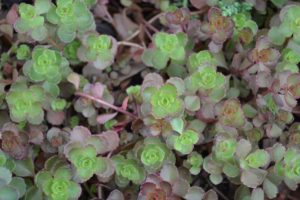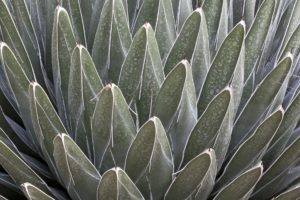Did you know that even if the area you live in gets frost during winter, you can still grow certain succulents (including cacti) outdoors year round? Although we generally think of succulents as exclusive to warm areas, some of them actually occur in habitats that can get rather chilly.
Keep reading for tips on overwintering frost hardy succulents and my 8 favorite frost hardy succulent species!
Growing succulents in cold weather
As you’re about to find out, there are more succulents out there than you’d think that can handle lower temperatures. However, their hardiness does not mean that these plants can just be left alone during wintertime. They do need a little extra help from you to be able to handle freezing temperatures.
First and foremost, the absolute most important factor to keeping your succulents alive through the coldest days is moisture. Or rather, lack thereof. Once things get below about 50 °F (10 °C), it’s best to stop watering your succulents and place them in a sheltered spot so rainwater can’t get to them. They won’t mind, as they won’t be growing actively anyway and have no use for moisture. Also stop fertilizing after summer ends.

As long as your succulents’ soil is bone dry and they have been placed in a spot away from the harshest rain and wind, they will have a good chance of survival if they’re among the frost hardy species. Their moisture-filled leaves are all they need. An additional winter care measure that you can use if temperatures are expected to dip hard for a couple of days is placing a blanket or plastic over the plants.
Frost Hardy Succulents
Hen and chicks (Sempervivum)
Sempervivum is a genus of succulents also known as houseleeks or hen and chicks. The latter common name is derived from the plants’ growth pattern: they’re monocarpic, meaning they only bloom once. During and after the blooming process, though, they’ll produce plenty of offsets that surround the mother plant like little chicks around a hen. The scientific name translates to ‘forever alive’, which also refers to this endless cycle of pupping.
Sempervivum are extremely hardy and probably the most popular choice in areas that receive frost. They make excellent ground cover in container gardens as well as rocky areas. Most varieties can handle temperatures as low as -30 °F or -34.5 °C, which makes it the hardiest plant on this list. Heat is no problem either. Although your Sempervivum will appreciate being shaded from the harshest sun, it handles high temps just fine.

Lace Aloe (Aristaloe aristata)
Although it’s a popular indoor plant, your Lace Aloe will also do well outdoors in some areas. This hardy species does well down to around 10 °F or -12 °C as long as the winter care guidelines that were discussed earlier are followed. In fact, like many succulents it actually needs cooler temperatures during wintertime in order to bloom properly once summer rolls around.
Grow your Lace Aloe in well-draining soil, using a pot that has drainage holes. Plenty of sun will be appreciated, although you might want to keep it away from the harshest afternoon rays in summer.

Two-row stonecrop (Sedum spurium)
There are quite a few species in the Sedum genus that don’t mind low temperatures, with Sedum spurium being one of the most popular ones. Although it will usually die back significantly after fall, it’ll bounce back come springtime. Known as hardy up to zone three, which can get lows of -30 °F or -37 °C, it can take pretty much anything you can throw at it.
If you’re not fond of the standard green Sedum spurium, there are also some amazing cultivars out there. ‘Dragon’s Blood’ lends its name from its spectacular dark red color, while ‘Tricolor’ features green leaves with pale pink edges. Although frost hardiness can vary a little between varieties, all of them produce the same lovely pink flowers during the warmer months.

Queen Victoria Agave (Agave victoriae-reginae)
There are quite a few Agave species that handle lower temperatures well enough, but the most spectacular choice is undoubtedly the Queen Victoria Agave. Easily recognized from its round growth pattern with thick green leaves and dazzling geometric white lines, it’s one of the smaller Agaves out there.
The Queen Victoria Agave can be grown in a pot or in full soil, wherever it will receive plenty of sun. It can handle temperatures as low as 15 °F or -9.5 °C, making it one of the less hardy succulents on this list. Still, in a sheltered spot it’ll do fine in many cases!

Ghost plant (Graptopetalum paraguayense)
If you’re looking for a frost hardy rosette succulent to grow, forget about Echeveria. Graptopetalum is where it’s at, especially the ghost plant (Graptopetalum paraguayense). Hardy down to around 5 °F or -15 °C, this lovely pale blue-grayish variety makes the perfect choice for a container garden. It’ll develop long stems that star-shaped rosettes hang down from.
Grow your ghost plant in well-draining soil. Provide plenty of sunlight, especially if you’d like the leaves to take on their yellowish summer colors, and don’t worry about high temperatures.

Titanopsis calcarea
The genus Titanopsis is as funky as they get: these succulents evolved to resemble stones. Originally found in South Africa, this species is perfect for the small succulent garden, as it rarely reaches sizes of more than 1.5” / 4 cm in height and 6” / 15 cm across.
During summertime, a healthy Titanopsis calcarea will reward you with lovely little yellow flowers. In the winter months it really does look like little more than a pot filled with warty stones, but at least it’ll be just fine until things warm up again. Temperatures as low as 5 °F or -15 °C are taken with no problem.

Purple ice plant (Delosperma cooperi)
The decorative purple ice plant makes the perfect ground cover choice, as it can form dense mats of small green foliage that turn into seas of glistening purple flowers during the summer months. In fact, you should be mindful of where you plant this one, as it can end up spreading significantly in as little as a year!
Like Titanopsis and many other of our favorite succulent plants, Delosperma Cooperi is naturally found in South Africa. Here, it grows in areas that can get quite chilly, hence its ability to survive low temperatures. Although its common name was derived from the frosted look of its leaves when the sun shines on them, it can also handle real ice. Many growers report it doing fine at temperatures down to -20 °F / -29 °C.

Chinese dunce cap (Orostachys iwarenge)
Naturally found in Japan (despite its common name), the Chinese dunce cap is a champion when it comes to cold hardiness. It can be kept outside year-round almost everywhere, as it has proven to do fine down to -30 °F / -34 °C.
Aside from being pretty much indestructible, the Chinese dune cap is also quite decorative. It naturally spreads by forming offshoots on long, thin stems, giving the appearance of spiders dangling from their webs. You can grow the plant in a wide, shallow container to achieve a full mat of rosettes. Alternatively, place it in a planter on a shelf and allow its offsets to dangle down.

About the cold-weather succulent growing author
Mari is a houseplant and gardening fanatic who turned her passion into her job, helping other (indoor) gardeners with her articles for YouHadMeAtGardening. Originally from The Netherlands, she now lives in Spain with her ever-expanding plant collection and pet parakeet Esmi.









HobbyGardener85 5 years ago
I love succulents. I live in a Northern part of Washington, so its cold here often. I’ll try some of these succulents!
Share